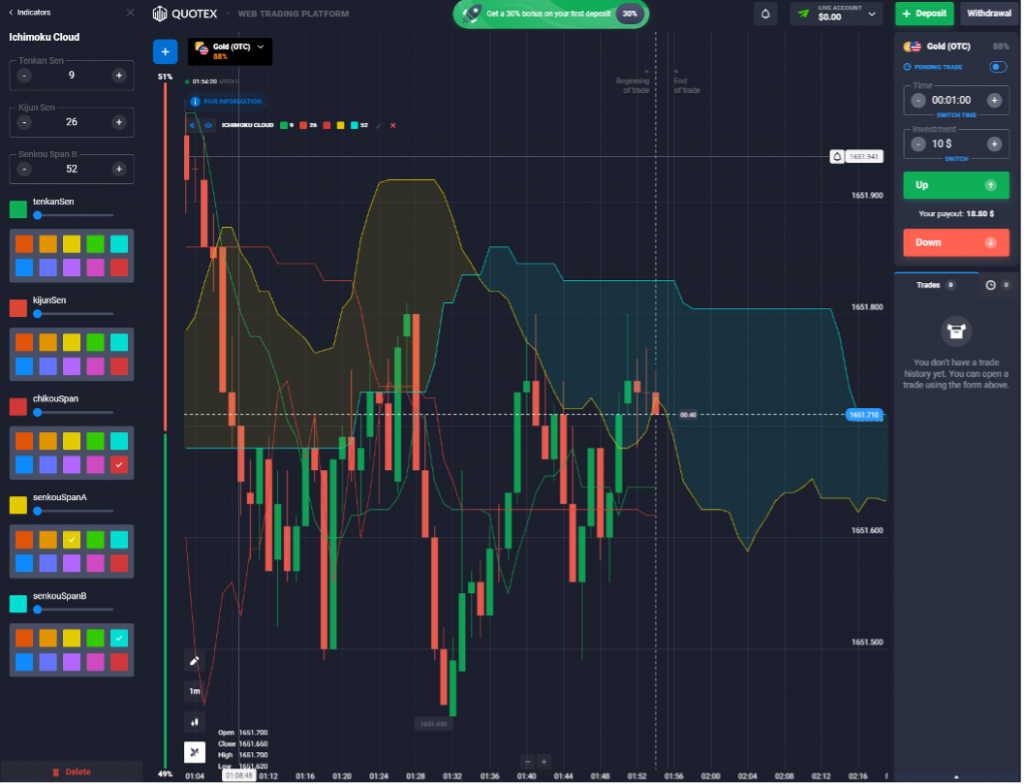Introduction:
As a seasoned options day trader, I’ve witnessed firsthand the transformative power of technical analysis in navigating volatile markets. One technique that has consistently guided my trading decisions is the Ichimoku Cloud, an indicator that combines multiple timeframes into a single, comprehensive chart.

Image: www.youtube.com
In this guide, we’ll delve into the ins and outs of day trading options with Ichimoku Cloud. We’ll explore its history, definition, and key components, helping you unlock the secrets of this powerful indicator and enhance your trading strategy.
Understanding the Ichimoku Cloud
Definition:
The Ichimoku Cloud (Ichimoku Kinko Hyo in Japanese) is a technical indicator developed by Goichi Hosoda in the 1940s. It visualizes market momentum, support, resistance, and future potential by incorporating a unique blend of trend, lagging, and leading indicators.
Components:
The Ichimoku Cloud comprises several key components:
- Tenkan-sen (Conversion Line): A moving average calculated over 9 periods.
- Kijun-sen (Base Line): A moving average calculated over 26 periods.
- Chikou Span (Lagging Span): The current closing price plotted back 26 periods.
- Senkou Span A (Leading Indicator 1): A moving average calculated over 52 periods.
- Senkou Span B (Leading Indicator 2): A moving average calculated over 26 periods.
These components combine to create the distinctive Ichimoku Cloud, which provides visual cues for trend direction, potential reversals, and areas of support and resistance.

Image: in.pinterest.com
Empowering Your Trading Strategy
Unveiling Market Momentum:
The Tenkan-sen and Kijun-sen form the backbone of the Ichimoku Cloud. When the Tenkan-sen crosses above the Kijun-sen, it indicates a shift to a bullish trend. Conversely, a crossover below the Kijun-sen signals a bearish trend.
Identifying Support and Resistance:
The Ichimoku Cloud itself acts as a dynamic support and resistance level. When prices are above the cloud, it suggests bullish momentum and potential for further gains. Conversely, prices below the cloud indicate bearish sentiment and potential for declines.
Predicting Future Direction:
The Senkou Span A and B form the “cloud” portion of the indicator. The space between these lines creates a visual representation of potential future price action. When prices are within the cloud, it indicates a period of consolidation. Breakouts above or below the cloud often provide trading opportunities.
Tips and Expert Advice
Mastering the Cloud:
Embrace patience and study the Ichimoku Cloud’s behavior over time. Understand how the cloud’s thickness and slope can influence market trends.
Balancing Indicators:
While the Ichimoku Cloud is a powerful indicator, it should not be used in isolation. Combine it with other technical analysis tools to enhance your understanding of market conditions.
Managing Risk and Reward:
Carefully consider your trade size and risk management strategies. Options trading carries inherent risk, so it is crucial to manage your potential losses.
FAQs
Q: Is the Ichimoku Cloud useful for day trading?
A: Yes, the Ichimoku Cloud provides valuable insights for day traders, offering potential signals for entry, exit, and risk management.
Q: Can I use the Ichimoku Cloud without indicators?
A: While the Ichimoku Cloud is comprehensive on its own, combining it with other indicators can enhance your analysis.
Q: How often should I monitor the Ichimoku Cloud?
A: For day trading, it is recommended to monitor the Ichimoku Cloud closely, especially during open market hours.
Day Trading Options With Ichimoku Cloud

Image: www.daytrading.com
Conclusion:
The Ichimoku Cloud is a versatile and valuable tool for day trading options. By grasping its components and leveraging its insights, you can empower your trading strategy and navigate market volatility with confidence.
Are you ready to unlock the power of the Ichimoku Cloud and elevate your options trading performance? Explore the resources available, follow the tips, and continuously refine your knowledge to enhance your trading journey.






